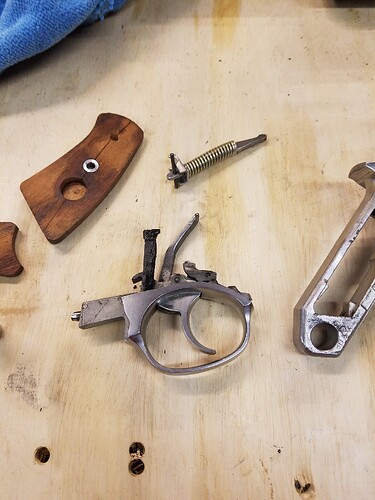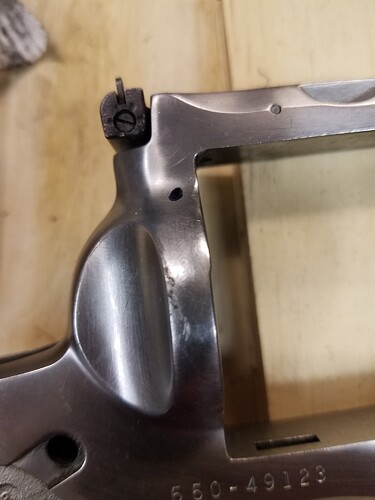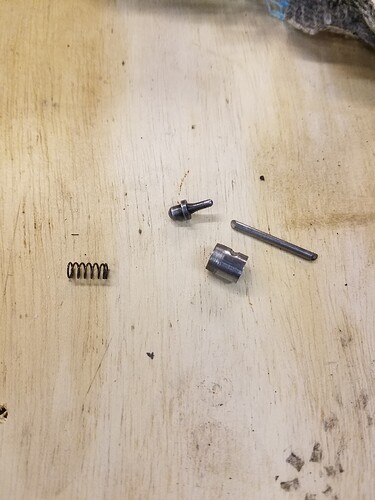Originally published at: RUGER’S .45 REDHAWK – Sixguns Firearm Fraternity
RUGER’S .45 REDHAWK
JOHN TAFFIN
In 1992 while on assignment touring gunmakers in the East, I found myself in Bill Ruger’s office to conduct an interview for this publication. I was ushered into his modest office which was piled high with gun magazines of every description, and which also contained some notable firearms as well as a prototype semi-automatic pistol on his desk. He left word with his secretary that we were not to be disturbed. We were just talking about things in general when we were interrupted by his secretary with a phone call that he was informed he had to take. Although I could only hear Bill’s end of the conversation, I knew it was not good news. As I sat there, Bill Ruger received the tragic word of the seriousness of his son Tom’s illness.
After the phone call we discussed this and then went into the interview. Sharing something as difficult as this with a man makes one seem very close to him. I’ve had a very special feeling for Bill Ruger ever since in addition to the appreciation I have always had for his firearms genius. In 1994, thanks mainly to Terry Murbach’s contact with Sturm, Ruger, 52 Shootist Commemoratives, 4 5/8″ stainless Steel Bisley Single-Sixes, were issued. All are marked IN MEMORY OF TOM RUGER. This little gun is pictured on the bottom left hand corner of page 267 in Wilson’s RUGER & HIS GUNS.
During our conversation I asked Ruger about bringing out a .45 Colt Redhawk. I have no way of knowing if that had any bearing on the decision but I at least like to think that the fact that we now have a Redhawk chambered in the grand old cartridge had something to do with our conversation that day.
Over the years the Redhawk has been offered in .357 Magnum and .41 Magnum in addition to the standard .44 Magnum offering. The two former chamberings are now long gone but the big .44 has been recently joined by the .45 Colt in, at least as of this writing, stainless steel models only. The Redhawk .44 Magnum is a very strong sixgun, along with its brother the Super Redhawk, probably the strongest double action .44 Magnum ever offered to sixgunners. Since the .45 Colt is built on the same platform, it is also probably the sturdiest double action .45 ever offered to shooters. The .45 Redhawk is available in both the easy packin’ 5 1/2″ version, as well as 7 1/2″ models both with and without the factory scope option that consists of two scallops on the barrel that accept Ruger scope rings.
Let us back up a bit here and look at both the cartridge and the sixgun that are combined to give us the .45 Redhawk. The .45 Colt, often erroneously referred to as the .45 Long Colt, first saw the light of day chambered in the now legendary Colt Single Action Army, the fabled Peacemaker of 1873. Being a black powder cartridge, the .45 Colt case is of large capacity, large enough to accept a full 40 grains of black powder under its 255 grain conical, or flat-nosed lead bullet. Muzzle velocities in the 1870’s were probably somewhere around 850-950 feet per second. Anyone acquainted with modern Magnum sixguns quickly notices that the cylinder walls on the Colt Single Action Army are very thin. However this was not a problem as the black powder load was a low pressure load.
When experimenters started heavy loading the .45 to take advantage of its larger case capacity with smokeless powders, the inevitable happened. Cylinders burst, top straps blew. Elmer Keith started his writing career in the 1920’s describing a blow-up of a .45 Colt Single Action Army .45. That incident caused him to give up on the .45 Colt and take up the .44 Special for the heavy loads he wanted to use.
Some said then, still do, that .45 Colt brass was weak. Perhaps it was in its old original black powder loading. Perhaps it still was at Keith’s time with folded, or balloon, head cases. However when Dick Casull started the experiments that lead to the .454 Casull he used the standard .45 brass available at the time. The balloon head brass had given way to the modern solid head brass and this is exactly what we have today and exactly what Casull used.
The missing strength factor in Casull’s work was not the brass case but the available sixguns. He blew several Colt Single Actions, then started fitting five-shot cylinders and finally built his own custom sixguns to house 230 grain bullets at 1800 fps, or more, all in standard .45 Colt brass.
It would be nearly 90 years after the advent of the Colt Single Action Army before we would see a single action strong enough to take advantage of the voluminous case capacity of the .45 Colt when using smokeless powder. That sixgun was Ruger’s .45 Blackhawk. These sixguns are certainly not as strong as Casull’s five-shooters so it behooves us to approach loading for the .45 Blackhawk with a great deal of common sense.
Modern .45 Magnum loads soon started to appear. Some sensible, some not so sensible. I settled on a load consisting of a 300 grain bullet first loaded over 18.5 grains of #2400 for 1100 feet per second and then 21.5 grains of either H110 or WW296. The latter load is around 1200 feet per second in a 7 1/2″ Ruger Blackhawk. It is plenty for my needs and I rarely exceed it in the relatively lightweight .45 Blackhawk.
Ruger’s Redhawk first appeared in 1980 offered in .44 Magnum at a price of $325. The first example to arrive locally went for $800! Why? Such was the state of affairs in trying to acquire a double action .44 Magnum in the late 1970’s that Smith & Wessons were often going for double the suggested retail price. It is hard to say who sold more Smith & Wesson .44 Magnums over the years, Elmer Keith with his writings or Clint Eastwood with his Dirty Harry “Make My Day” portrayal.
We do know that Dirty Harry caused the immediate problem as their were many more buyers of .44 sixguns than there were sixguns. Smith & Wesson worked around the clock but could not keep up with the demand. It was only the arrival of the Ruger .44 Magnum Redhawk that provided a safety valve that soon allowed everything to resume to some form of normalcy.
Ruger not only had an advantage in bringing their .44 Magnum double action sixgun out at the right time, they also built their gun around the cartridge rather than chambering some existing model for the powerful .44 Magnum. This made it the strongest sixgun ever offered for the .44 Magnum up to that point. Ruger engineers were able to do this without giving us an extra heavy or clumsy sixgun. The only fault most of us can find with the Redhawk is the fact that it is difficult to get a really good trigger on Big Red.
It is strange to read the account of the engineers and designers of the Redhawk as they talk about the smooth double action trigger pull and good single action pull. Not quite. My two test guns have single action trigger pulls that measure 6 3/4 and 6 1/4 pounds.
The Redhawk gains its strength in many ways. The threaded area of the frame is very thick, double what one finds in many other sixguns, and the massive cylinder is locked at the rear and front of the cylinder itself rather than at the end of the ejector rod. The barrel carries a heavy rib and the top strap literally speaks of brute strength. Like the single action Blackhawk, the double action Redhawk just keeps going. And going. And going.
For testing the .45 Colt in the Redhawk, I ordered a scope ready 7 1/2″ version, complete with Ruger rings for mounting a 2X Burris LER pistol scope, and 5 1/2″ easy packin’ version. The latter was soon equipped with the easy to see baby blue Ruger front sight, and to help soften recoil of some of the loads used, a pair of Uncle Mike’s finger groove grips replaced the factory wood stocks. I was fortunate to have a pair of grips from the late Deacon Deason of BearHug Grips laid back for the 7 1/2″ .45 Colt Redhawk. Both sets of grips were appreciated with the loads that were used in test-firing both .45 Redhawks including 265 grain bullets at 1465 feet per second, 335 grain bullets at 1275, and 360 grain bullets at 1180.
With the scoped .45 Redhawk accuracy proved to be exceptional. Even more so in light of the heavy trigger pull. Of all the loads tested, five factory heavy duty hunting loads, and twenty-three handloads using both cast and jacketed bullets and weights from 250 grains up to 335 grains, the average group size for five shots at twenty-five yards with all twenty-eight loads proved to be just over one-inch. I call that astounding accuracy.
Factory hunting loads tested included two from Buffalo Bore and two from Cor-Bon. Buffalo Bore’s 300 grain Speer bulleted load clocks out at 1367 feet per second over the sky screens of the Oehler Model 35P and places five shots in three-fourth’s of an inch at 25 yards. The Buffalo Bore 325 grain LBT load exhibits the same accuracy with a muzzle velocity of 1392 feet per second. These are not faint-hearted loads! They are for use only in modern, heavy-framed .45 Colt sixguns.
Cor-Bon’s serious .45 Colt hunting loads including a 265 grain Bonded Core +P at 1347 feet per second and a 300 grain Bonded Core +P at 1271 feet per second. Both loads are right at one-inch for accuracy at 25 yards.
The above are for big boned, heavy muscled critters. For whitetails my preferred .45 Colt load is Hornady’s 250 grain XTP bullet over 20 grains of Alliant #2400. In the 7 1/2″ Redhawk this load clocks out at 1137 feet per second and has near pin point accuracy with five shots in seven-eighth’s of an inch. Full test results of all loads are in the accompanying table.
Having just received a shipment of cast bullets from Cast Performance Bullet Company, I immediately put the .45’s from LBT bullet molds to use in the Redhawk. All loads were assembled with Winchester’s 296 and CCI #350 Magnum primers. The 265 over 26.0 grains yielded 1464 feet per second and a group of one-inch; the 325, 21.0 grains, 1234 feet per second, also one-inch; the 335 with the same charge came in at 1275 feet per second and 1 1/8″, while the super heavy 360 over 19.5 grains grouped into 1 1/4″ with a muzzle velocity of 1180 feet per second. All of these loads will penetrate from here to Sunday.
The Redhawk has been a most popular hunting handgun in its original .44 Magnum chambering. So much so that it was joined rather than supplanted by the Super Redhawk as Ruger had planned. The Redhawk was simply in too much demand to drop. There is a large segment of the sixgun shooting population that holds to the idea that anything the .44 can do the .45 can do better. The .45 Redhawk is definitely for them.
In firing several hundreds of heavy .45 Colt rounds through the Redhawks, no malfunctions of any kind occurred. This is, of course exactly as we have come to expect it from Ruger sixguns.
We have mentioned that both the .357 Magnum and .41 Magnum chamberings were available in the Redhawk. Both began in 1984 and both were subsequently dropped in 1991. I expect the .45 Colt to have a much longer run.
TEST FIRING
|
HEAVY DUTY FACTORY LOADS |
|||
|
LOAD |
GROUP/25 YDS | MV 7 1/2″ | MV 5 1/2″ |
| Buffalo Bore 300 Speer | 3/4″ | 1367 | 1327 |
| Buffalo Bore 325 LBT | 3/4″ | 1392 | 1339 |
| Cor-Bon 265 BC +P | 1″ | 1347 | 1336 |
| Cor-Bon 300 BC +P | 1 3/8″ | 1271 |
1252 |
| 4-W 328 LBT +P | 1 1/4″ | 1338 |
1292 |
| HEAVY DUTY HUNTING LOADS | |||
| Hornady 250XTP/20.0 gr. #2400 | 7/8″ | 1137 | 1080 |
| Hornady 300XTP/21.2 gr. H110 | 1″ |
1064 |
958 |
| BRP 300 GC/21.5 gr. WW296 | 7/8″ | 1240 | 1208 |
| Swift 265 JHP/26.0 gr. WW296 | 1 1/4″ | 1415 |
1371 |
| LBT 260 KT/10.0 gr. Unique | 3/4″ | 1059 |
1043 |
| LBT 260 KT/21.0 gr. #2400 |
1 3/8″ |
1294 | 1280 |
| CPBC 265 LBT/26.0 GR. WW296 | 1″ | 1464 | 1380 |
| CPBC 325 LBT/21.0 GR. WW296 | 1″ | 1234 | 1205 |
| CPBC 335 LBT/21.0 GR. WW296 | 1 1/8″ | 1275 | 1201 |
| CPBC 360 LBT/19.5 GR. WW296 | 1 1/4″ | 1180 | 1154 |
| Lyman 454424/18.5 gr. #2400 | 1 1/4″ | 1093 | 1056 |
| Lyman 452490GC/23.0 4227 | 1 1/8″ | 1165 | 1148 |
| Lyman #452490GC/20.0 gr.#2400 | 7/8″ | 1306 | 1226 |
| Lyman #457191/18.5 gr. #2400 | 1 3/8″ | 1108 | 1095 |
| NEI 310KT/21.2 gr. H110 | 1 1/8″ | 1217 | 1143 |
| NEI 325KT/21.2 gr. H110 | 1 1/4″ | 1208 |
1152 |
| Sierra 240 JHP/24.0 gr. H4227 | 7/8″ | 1058 | |
| Sierra 240 JHP/25.0 gr. WW296 | 1 3/8″ | 1250 | |
| Sierra 240 JHP/26.0 gr. WW296 | 7/8″ | 1301 | |
| Hornady 250 JHP/24.0 gr.H4227 | 1 1/2″ | 1087 | |
| Hornady 250 JHP/26.0 gr.WW296 | 1 1/2″ | 1292 | |
| Hornady 250 XTP/26.0 gr. H110 |
1 3/8″ |
1364 | |
| Speer 260 JHP/24.0 gr. H4227 | 3/4″ | 1124 | |
….Courtesy of GUNS Magazine





